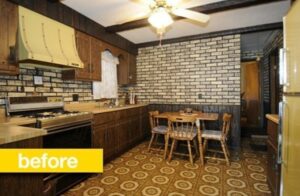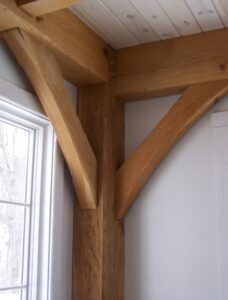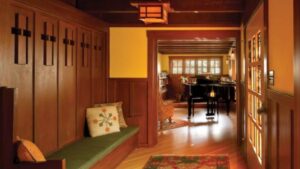 “Someone thought those ceiling beams were beautiful. It would not have been me.” Debra Silber wrote this recently in an article for “Fine Homebuilding” magazine on what makes a house beautiful. And while I agreed with most of the article, I disagreed with her comment about the ugly ceiling beams. I am confident that no one ever really looked at them and said “these are beautiful”. So why were they there?
“Someone thought those ceiling beams were beautiful. It would not have been me.” Debra Silber wrote this recently in an article for “Fine Homebuilding” magazine on what makes a house beautiful. And while I agreed with most of the article, I disagreed with her comment about the ugly ceiling beams. I am confident that no one ever really looked at them and said “these are beautiful”. So why were they there?
I think the homeowner who added those ceiling beams liked the idea of them. They had seen real timber frame beams they loved and wanted to re-create that look in their own home. So their contractor dutifully went out and found some economical “beams” he could add to the existing ceiling. They had the same dimensions as a real wood beam, were painted a similar brown color, and even had a similar texture. But they weren’t beautiful. Their color and texture didn’t have the complexity of real wood; they weren’t installed with the craftsmanship of timber frame joinery; they weren’t part of a visible skeleton expressing the mathematics of the structural system supporting the house and its occupants. They weren’t reminders of the forests that had been on the site before the house was built. They just looked like they were trying to be something they weren’t.
ceiling. They had the same dimensions as a real wood beam, were painted a similar brown color, and even had a similar texture. But they weren’t beautiful. Their color and texture didn’t have the complexity of real wood; they weren’t installed with the craftsmanship of timber frame joinery; they weren’t part of a visible skeleton expressing the mathematics of the structural system supporting the house and its occupants. They weren’t reminders of the forests that had been on the site before the house was built. They just looked like they were trying to be something they weren’t.
Building a house is like cooking. Some basic ingredients can provide sustenance, but it may not be very appetizing. A cook using a good recipe can take those same ingredients and turn them into something you would be happy to eat. But to come up with the recipe, or better yet to actually prepare a gourmet meal, you need a chef: someone who is fascinated by flavors and the foods that create them; someone who has spent years studying cooking; someone who knows the difference between a shallot and an onion.
That’s what an architect provides when you are building or remodeling your home: someone who is analyzing the elements that create the “flavors” of a house nearly every time she walks into, or even drives past one. An architect would have been able to tell the family considering those ceiling beams they probably weren’t going to be happy with them. She could have helped them to understand the difference between the beautiful beams they had admired and the faux beams they were considering. And she could have helped them find a way to accomplish their real goal- getting a more beautiful space- in a way that was appropriate to their house and their tastes and that fit their budget. A contractor can build an addition or new house, or renovate an existing one, but he isn’t going to spend much time stopping to look at the design and ask “Is this the best way to do this, or is there a better or more beautiful solution?” A contractor’s passion is in building, not designing.
Once you are living in your new or remodeled home, you will notice if there is enough natural light. You’ll notice if the snow builds up in front of the front door. You’ll notice if you have to walk past the dirty laundry every time you come in from the garage. You’ll notice if you have ice dams every winter. And you’ll notice whether or not you find your home beautiful. But you may not notice these things when you look at drawings of the house. You may not even know to ask about them. That’s okay. Most of us aren’t gourmet chefs either. When you pick out a cookbook, or choose someone to cater an important event, you rely on people who are passionate about food. So when you design your home, work with someone who is passionate about beautiful homes. Work with someone who walks into a room and notices where the light is coming from, the use of materials and texture, the use of symmetry or asymmetry, how the circulation works, the scale of the space. Work with an architect and you won’t end up with not-so-beautiful beams no one ever really looked at or thought about until after they were installed. In their place you will have thoughtfully designed elements that add to your enjoyment of your home.

Darling-Wright House by Greene & Greene
